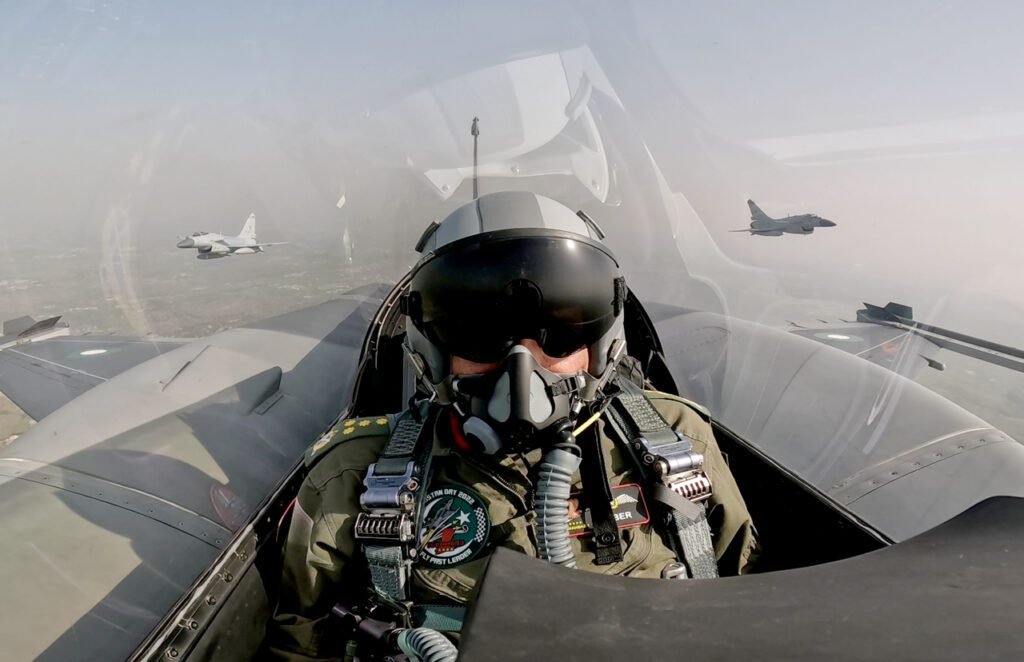Epistemic Erasure and the PAF’s Men Behind Machines
Ameer Abdullah Khan
22 June 2025


The spectacular display of air power by the Pakistan Air Force (PAF) in the May 2025 conflict with India created awe and shock within the global aviation circles. However, as the headlines for this largest modern-day air combat emerged, it was not the PAF’s strategy or its pilots’ proficiency that received admiration. Rather, Western media outlets deliberately reduced the PAF’s accomplishment to footnotes and reported the whole saga as a victory for Chinese military equipment. This, at best, can be described as epistemic erasure.
As the new Kashmir crisis started unfolding in late April 2025, the Indian Air Force (IAF) placed its confidence in its French-origin Rafael aircraft, equipped with Meteor beyond-visual-range (BVR) missiles and a cutting-edge electronic warfare (EW) system, Spectra. Accompanied by formidable Su-30MKIs, MiG-29s and Mirage 2000s, the IAF was quantitatively superior and qualitatively on par with the Pakistan Air Force (PAF). Yet the PAF inflicted humiliating losses upon the IAF and destroyed seven aircraft, including three Rafael and a Heron drone.
The PAF’s achievement, as reported in Western media, was largely attributed to the Chinese J-10C fighter and the BVR PL-15E missiles, while conveniently ignoring that Pakistan’s response was not a haphazard sortie but rather a doctrinally refined and technologically synchronised manoeuvre. Chinese-origin hardware deployed within Pakistan’s command-and-control matrix ensured real-time situational awareness and tactical precision. However, Pakistan solely relied on its own sources in the 96-hour conflicts with India without getting any external aid. Most importantly, it was the well-integrated “kill chain” choreographed under the dynamic leadership of Air Chief Marshal Zaheer Ahmad Baber Sidhu which proved the PAF’s trump card. Over the past four years, the PAF has orchestrated a system comprising coordinated airborne early warning systems, ground-based radars, satellite data, and combat air patrols. Moreover, a seamless induction and execution of EW systems, cyber and space technologies, drones and the CM-400AKG hypersonic missiles created a lethal sensor-to-shooter loop.
Resultantly, the PAF Pakistan’s pilots were integrated into a larger multi-domain operational ecosystem, designed and perfected by the PAF leadership. This integrated kill chain, in which sensors, data link systems, decision-making nodes, and weapon platforms function as a cohesive unit, allowed the PAF to outmanoeuvre the IAF. Therefore, the notion that success hinged solely on the J-10C’s capabilities undermines the doctrinal success of the PAF, given that India also possesses highly potent platforms but was neutralised by a smaller but more agile and better-prepared force.
Surprisingly, the Western media remained fixated on the geopolitical implications of China’s military technology, instead of highlighting the PAF’s superior operational doctrine. Reuters framed Pakistan’s victory as a result of its deployment of Chinese hardware, and BBC, CNN, the Asia Times, and the Times of London went further, proclaiming that China was the real winner of the conflict. Similarly, the National Interest, Time, France 24, NZZ, and many others covered the development through the same lens. Ironically, the central actor, the PAF, was notably absent from most of these analyses.
This relegation of the PAF to small letters was deliberate. The narrative framed by the Western media reflects epistemic erasure. The term refers to denying agency and voice to non-Western actors unless mediated through the lens of the West’s choosing, which in this case was the great power competition. Postcolonial theorists like Edward Said argue that the West perceives the East as a stage on which the drama of Western civilisation or its rivals unfolds. Similarly, the PAF’s strategic and tactical brilliance was reduced to a footnote in the US-China tale.
The framing by the Western media reflects a broader pattern of epistemic erasure. It denotes that an emphasis on external factors deliberately overshadows the intellectual and operational contributions of non-Westerners. Miranda Fricker’s concept of epistemic injustice further explains this process, arguing that individuals or groups are wronged specifically in their capacity as knowers. Fricker further asserts that testimonial injustice occurs when someone is not given the credit they deserve because of prejudice. Consequently, PAF’s excellence was discounted not due to any evidentiary shortcoming but rather because of the entrenched assumptions about who can be capable, strategic, or victorious in the eyes of the West. Western media, by attributing the PAF’s success entirely to Chinese equipment, effectively silenced the role of the PAF’s leadership, its doctrine and ace pilots. Moreover, they provided a face-saving to their ally India by not comparing the strategies and tactics but rather the machines. It was an attempt to save India from humiliation by highlighting the fact that they were defeated by a better technology, not a better strategy. This modern form of epistemic erasure, though less visible than colonial conquest, is equally insidious in its implications.
There is no denying that China’s hardware played a vital role in the PAF’s victory; however, one must not forget that aircraft do not fly themselves, nor do they decide on engagement tactics, threat assessment, or evasion. Such decisions are made by strategy maestros who lead, interpret and adapt. These are the men behind machines who matter, and the PAF’s victory was not gifted to it by some hardware but was rather earned in the command room at the Air Headquarters and the cockpits. It is time for the Western media to accept that its reporting perpetuates an outdated worldview. They cannot continue to be those who mistake hardware for heroism and geopolitics for merit.


The Centre for Aerospace & Security Studies (CASS) was established in July 2021 to inform policymakers and the public about issues related to aerospace and security from an independent, non-partisan and future-centric analytical lens.

@2025 – All Right Reserved with CASS Lahore.